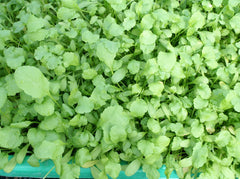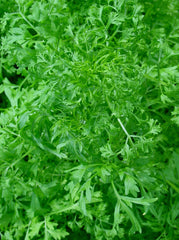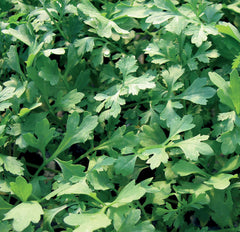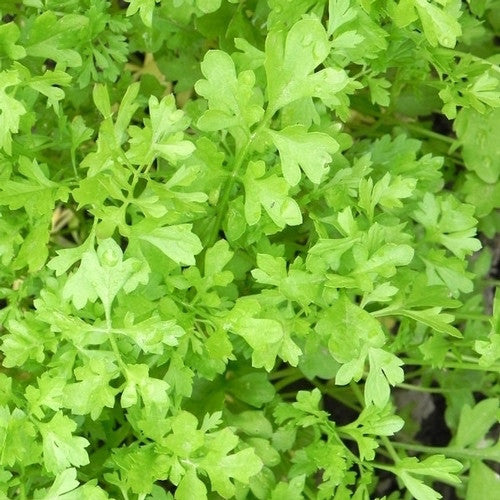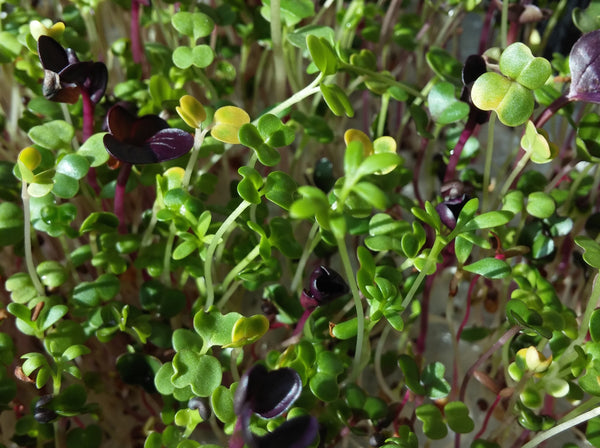Curled Peppergrass garden cress
curled-peppergrass-garden-cress Curled Peppergrass garden cress "Lepidium sativum
HOW TO GROW GARDEN CRESS
Direct sow in the spring as soon as the ground can be work or outdoors in the fall. Broadcast seed and cover very lightly with soil or compost. A small patch, 1–2’ square, provides plenty of cress. Edible shoots are typically harvested in one to two weeks after planting, when they are 2–5” tall (5–13 cm). Fast growing herb, can mature in 20-30 days from sowing. Also quick to bolt so requires frequent successional sowings. You can intercrop cress with carrots or radishes, or mix it with other salad green crops. Keep well watered and provide shade when weather warms. Cover with fabric row covers if flea beetles or other pests are a problem. Soil pH 5.6–7.5. Hardiness zones 7. Annual.
Usual seed life: 5 years.
Planting Depth 1/4–1/2"
Soil Temp. Germ. 55–75˚F
Days to Germ. 2–7
Plant Spacing 3–6”
Row Spacing 12–18”
Days To Maturity 10–50
Full Sun, Moist Well Drained Soil
Usual seed life: 5 years.
Planting Depth 1/4–1/2"
Soil Temp. Germ. 55–75˚F
Days to Germ. 2–7
Plant Spacing 3–6”
Row Spacing 12–18”
Days To Maturity 10–50
Full Sun, Moist Well Drained Soil
Curled Peppergrass Seed Count
1 Ounce ≈ 12,886 seeds
.25 Pound ≈ 51,545 seeds
1 Pound ≈ 206m seeds
- 250 Seeds$3.25
- 1 Ounce$6.00
- 1/4 Pound$11.00
- 1 Pound$40.00
This slow bolting garden cress produces plants up to 8 inches tall with dark-green, finely-cut, curled leaves. It adds a pungent peppery, tangy flavor to a wide variety of dishes. It is also eaten as sprouts, and the fresh or dried seed pods can be used as a peppery seasoning. In England, cut cress shoots are common...
This slow bolting garden cress produces plants up to 8 inches tall with dark-green, finely-cut, curled leaves. It adds a pungent peppery, tangy flavor to a wide variety of dishes. It is also eaten as sprouts, and the fresh or dried seed pods can be used as a peppery seasoning. In England, cut cress shoots are commonly used in sandwiches with boiled eggs, mayonnaise and salt. Plants exhibits a compact growth of dark green, flat dissected leaves. Garden cress is genetically related to watercress and mustard, sharing their peppery, tangy flavor and aroma. Garden cress seeds are bitter and serve as a diuretic. They are useful in the treatment of asthma, coughs with expectoration, poultices for sprains, skin disease, diarrhea, scurvy and seminal weakness. Also known as Peppergrass. Tags: Color: Green, Specialty: Sprouting, Season: Spring Fall.
Native to Egypt and Middle East, cultivated in Persia around 400 B.C. Spread many centuries ago to western Europe. The word cress is from old germanic cresso which means sharp, spicy. Garden cress seeds, since ancient times, have been used in local traditional Ayurvedic medicine of India. Today Garden cress is commercially grown in England, France, the Netherlands and Scandinavia. Garden cress is suitable for hydroponic cultivation and thrives in slightly alkaline water. In many local markets, the demand for hydroponically grown cress can exceed available supply, partially because cress leaves are not suitable for distribution in dried form, so can be only partially preserved. Consumers commonly acquire cress as seeds or (in Europe) from markets as boxes of young live shoots. Delicious garden cress recipes."
Native to Egypt and Middle East, cultivated in Persia around 400 B.C. Spread many centuries ago to western Europe. The word cress is from old germanic cresso which means sharp, spicy. Garden cress seeds, since ancient times, have been used in local traditional Ayurvedic medicine of India. Today Garden cress is commercially grown in England, France, the Netherlands and Scandinavia. Garden cress is suitable for hydroponic cultivation and thrives in slightly alkaline water. In many local markets, the demand for hydroponically grown cress can exceed available supply, partially because cress leaves are not suitable for distribution in dried form, so can be only partially preserved. Consumers commonly acquire cress as seeds or (in Europe) from markets as boxes of young live shoots. Delicious garden cress recipes."
Learn More
Reviews
